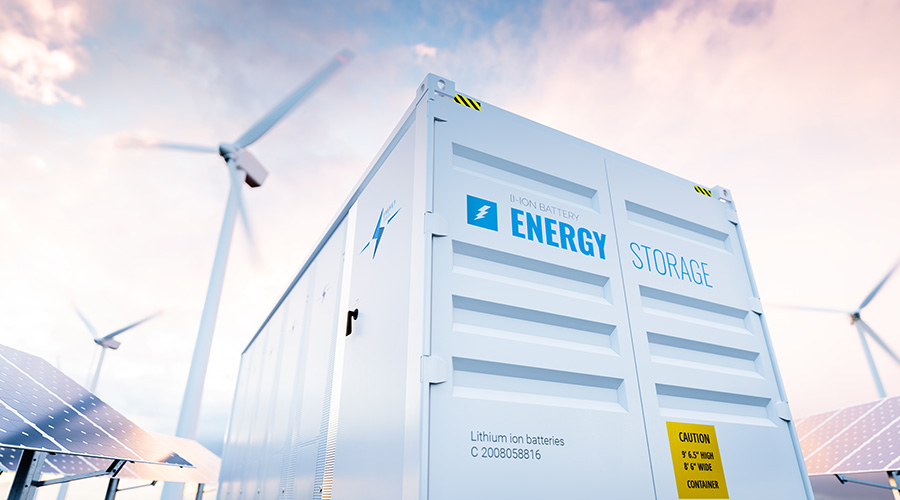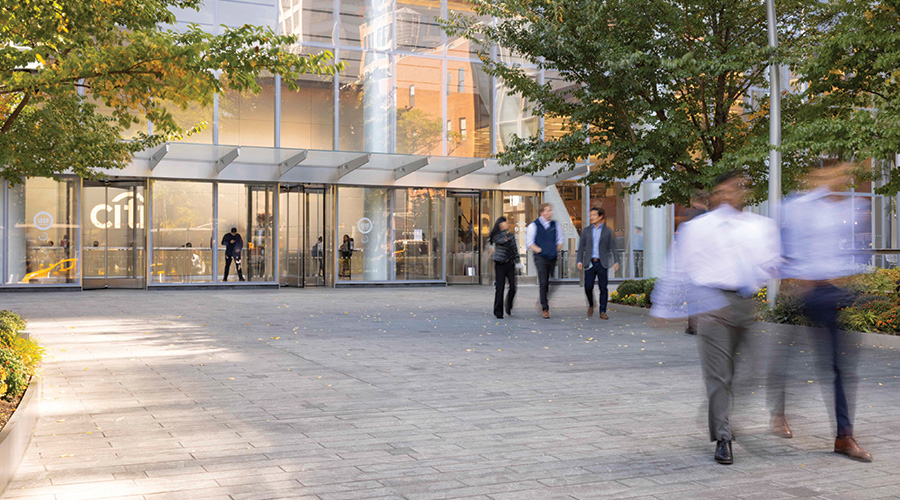Vendors Pursue LEED-NC, LEED-EB
From practically the moment of its birth in 2001, some of the most enthusiastic adopters of the U.S. Green Building Council’s Leadership in Energy and Environmental Design (LEED) rating system have been product manufacturers and vendors. The main reason is clear: credibility. Vendors selling products or services to help facility executives meet green goals have a lot of motivation to be green themselves to prove that they are leading by example.
From the original New Construction (LEED-NC) rating system to Commercial Interiors (LEED-CI) and Existing Buildings (LEED-EB), the LEED rating systems became the nationally recognized proof of commitment to sustainability in a vendor’s own space — whether corporate office space, product showrooms or even manufacturing facilities.
Today, LEED certification stands as one of the most recognizable and credible strategies to show that an organization is truly committed to being environmentally responsible. Regardless of the type of product manufactured or service offered, these vendors are operating sustainable and occupant-friendly facilities that are water- and energy-efficient, maintain good indoor air quality, and use materials and resources that minimize the facility’s environmental footprint.
What’s more, each vendor brings knowledge of its own products and services to its facility to show facility executives how those products and services can contribute to LEED certification for other buildings. So facility executives can learn valuable lessons about how to apply technology in their own spaces by studying these vendor LEED-certified buildings.
Office Space
LEED-NC set the stage for the structure of all the subsequent rating systems. Two vendor facilities where the LEED-NC rating system has been used successfully are the 185,000-square-foot Hubbell Lighting Headquarters in Greenville, S.C., and Johnson Controls, Inc.’s 130,000-square-foot Brengel Technology Center in Milwaukee.
The Hubbell Lighting Headquarters was certified at the LEED Silver level on March 18, 2008. Energy efficient lighting fixtures and daylight-harvesting and occupancy-sensing lighting controls systems were some of the strategies that have helped the company save nearly $150,000 per year on energy compared with a traditional building. The building includes office space, a laboratory and a Lighting Solutions Center to “educate and train end users, engineers, architects and lighting consultants in a flexible, informative and entertaining manner,” says Ken Beale, director, marketing services.
Energy efficiency was also an important facet of the thinking behind the Brengel Technology Center — the headquarters for Johnson Controls’ Building Efficiency business. One of the first buildings to be LEED-NC certified (in 2001 at the Silver level), the Brengel Technology Center uses a “very sophisticated building automation and management system, including real-time metering of energy use and alarms for energy use patterns that fall out side the norms,” says Steve Thomas, manager of global energy and sustainability communications. “This allows us to catch and address problems very quickly.”
The building includes controls that allow occupants to adjust their personal environment to their liking. Thomas says that full lighting and space conditioning do not come on until 30 percent of the cubicles in a space are occupied in the morning. The building uses 0.86 watts per square foot, about 30 percent less than the state energy code of 1.2 watts per square foot.
“We think energy efficiency is the fastest, cheapest and best way for our country to save both money and the environment,” says Thomas. The Brengel Technology Center was also the first LEED-NC certified building in the country to be certified under LEED-EB as well. Johnson Controls saw the LEED-EB rating systems as an opportunity to improve on its sustainable goals achieved with its LEED-NC Silver certification. The company achieved a LEED-EB Gold certification in 2004. Strategies included implementing a green cleaning program, tracking energy with its sophisticated energy metering system and encouraging occupant recycling.
For other organizations, the advent of LEED-EB represented an opportunity to improve sustainability in office buildings built before the LEED-NC rating system was developed. And Johnson Diversey and Armstrong World Industries have both taken advantage.
Located in Lancaster, Pa., the 126,000-square-foot Armstrong World Industries headquarters facility, also known as Building 701, is one of only 14 facilities to be LEED-EB certified at the Platinum level. The building, originally built in 1998, was designed before LEED-NC had been launched but followed many of the principles of that rating system. For example, the building uses narrow floorplates and light shelves so that much of the facility has access to daylight. “The exterior light shelves shade the windows, which reduces glare and minimizes solar heat gain in summer,” says Jim Baker, director of facilities management.
Those steps paid an unanticipated dividend when the company decided to seek LEED-EB certification in 2007. Because of the green elements in the original design, the facility didn’t require major capital investment to qualify for LEED-EB.
The company invested $138,000 in strategies to pursue LEED certification, but expects to have that capital repaid in fewer than three years due to energy and water savings.
“We knew it was a wise decision to evaluate our fairly new corporate headquarters and systematically approach LEED certification,” says Baker. “As we became more involved in the process, it was evident that Platinum certification was attainable, so we went for the best we could.”
With the installation of waterless urinals, dual-flush toilets and water sensors for faucets, the company nearly halved its annual potable water use from 800,000 to 420,000 gallons per year.
In 2008, for the second time in two years, the facility earned the ENERGY STAR designation, scoring a 93, according to Baker. Additionally, 75 percent of the building’s power comes from renewable wind energy. The acoustical ceiling products manufacturer’s headquarters facility also became the first facility to garner an Innovation point for acoustical performance.
Johnson Diversey’s 277,440-square-foot global headquarters, located in Sturtevant, Wis., was built in 1997 and earned its LEED-EB certification at the Gold level in 2004. The mixed-use facility includes office space, research and development areas and a data center.
One of the company’s core businesses is to help other organizations achieve LEED-EB certification with its Healthy High Performance Cleaning program, so LEED-EB certification for its own facilities “affirmed our company’s corporate interests in pursuing sustainable business practices for the future,” says Stu Carron, director of global facilities and real estate.
According to Carron, with original energy efficiency measures such as occupancy sensors, efficient fluorescent lighting, sophisticated heat recovery systems and a building automation system, the company had saved more than $90,000 per year between the time the building opened and 2004 relative to a similar building without energy efficiency measures. To complete LEED-EB goals, the company instituted an ongoing energy management program in 2004 and has saved an additional $50,000 per year.
The company saves about 2 million gallons of water per year by installing aerators in showers and faucets, converting faucets from 2.5 gpm to 0.5 gpm and showers from 2.5 gpm to 1.8 gpm. The company also has installed replacement valve diaphragms to reduce water use in toilets and urinals and uses an irrigation system that operates solely on captured rain and recycled site water.
“LEED-EB has provided the framework for continuous improvement in our operating programs, and especially our focus on energy,” says Carron.
Green on the Inside
USGBC introduced its LEED-CI rating system in 2004. The goal of the rating system is to provide a LEED option for organizations that lease space within a multitenant facility, or that want to focus on sustainable interior strategies for a single part of their own corporate office space.
USGBC intended LEED-CI as a complement to the LEED for Core and Shell (LEED-CS) rating system, which is geared toward developers. One example of this symbiotic relationship between the two rating systems is Allsteel’s Atlanta Resource Center. The 15,000-square-foot space, LEED-CI certified at the Gold level in 2007, is located on the 24th floor of the 41-story 1180 Peachtree building, a pre-certified LEED-CS building. Pre-certification is a special designation that applies to LEED-CS only. It allows developers to have their design certified before the building is completed so that they can begin marketing their soon-to-be LEED-certified space.
The building’s LEED-CS pre-certification was an important consideration in selecting it for a 12-year lease, says Keri Luly, Allsteel’s manager of sustainability programs. To optimize its energy efficiency, the organization used all ENERGY STAR equipment and appliances, and selected energy-efficient lighting that reduces its lighting energy use about 35 percent compared with national standards, according to Luly.
Another furniture manufacturer, Herman Miller, used LEED-CI to certify a 31,500-square-foot space (B-West) in its Zeeland, Mich., corporate headquarters. Built in 1968, the space was still functioning efficiently, but “the interior was no longer providing the needed environment for collaborative work,” says Susan Koole, corporate communications.
The space, certified at the Gold level in December 2008, uses 35 percent less lighting energy than the ASHRAE 90.1-2004 standard, and the company buys 100 percent of its energy from renewable sources. Renovations in the restrooms included installing waterless urinals and faucet sensors. The company used one of its own products to achieve a LEED-CI credit for controllability of systems, temperature and ventilation.
Showroom space has also been a successful candidate for LEED-CI certification, as evidenced by Invista and Milliken. Both have LEED-CI certified space within Chicago’s Merchandise Mart.
Invista’s 2,800-square-foot Antron Brand Showroom was certified at the Gold level in December 2008. The space was built in 1983 and renovated to LEED-CI standards in June 2008. “Energy reduction was a major focus of the renovation,” says Melissa Noebes, Antron brand manager. To reduce energy use, the company installed programmable lighting and HVAC controls, as well as LED accent lighting and ENERGY STAR appliances.
Invista earned an innovation point for reusing $17,000 worth of glass doors and another for a display in the showroom about carpet recycling and reclamation. The company earned points for purchasing green energy for two years.
Milliken’s space in the Merchandise Mart is also certified at the Gold level. The company has a Gold-certified showroom at the Greeley Square Building in New York City, as well. Both showrooms focus on energy-efficient lighting that will also display products most attractively. The company earned credits for reusing furniture, lighting and audio/visual equipment from other Milliken facilities.
“Both LEED-certified spaces have been tremendously successful as selling tools with a dramatic increase in customer traffic,” says Bill Gregory, director of sustainability. “The sales force feels the showrooms now offer a more productive environment in which to engage customers.”
Related Topics:












